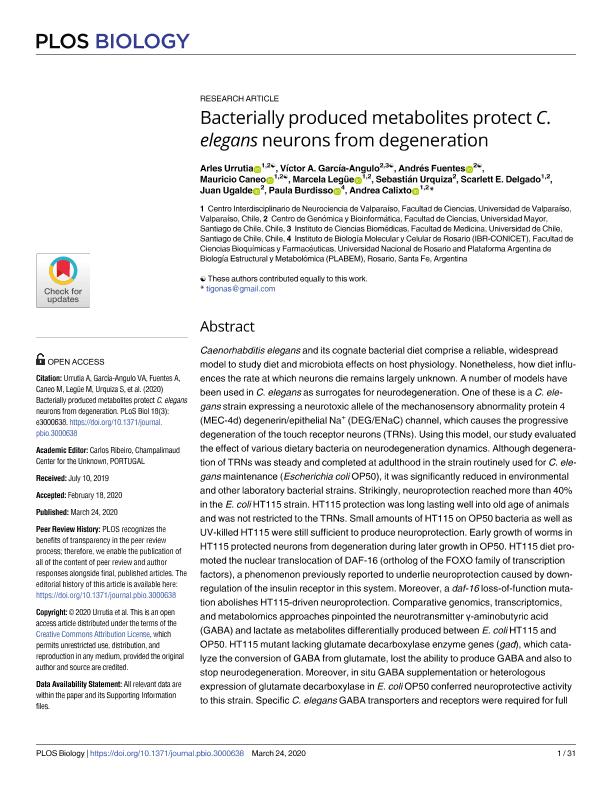Mostrar el registro sencillo del ítem
dc.contributor.author
Urrutia, Arles
dc.contributor.author
García Angulo, Víctor Antonio

dc.contributor.author
Fuentes, Andrés
dc.contributor.author
Caneo, Mauricio
dc.contributor.author
Legüe, Marcela
dc.contributor.author
Urquiza, Sebastián
dc.contributor.author
Delgado, Scarlett E.
dc.contributor.author
Ugalde, Juan Esteban

dc.contributor.author
Burdisso, Paula

dc.contributor.author
Calixto, Andrea
dc.date.available
2022-12-30T02:10:46Z
dc.date.issued
2020-03
dc.identifier.citation
Urrutia, Arles; García Angulo, Víctor Antonio; Fuentes, Andrés; Caneo, Mauricio; Legüe, Marcela; et al.; Bacterially produced metabolites protect C. elegans neurons from degeneration; Public Library of Science; PLoS Biology; 18; 3; 3-2020; 1-31
dc.identifier.uri
http://hdl.handle.net/11336/182883
dc.description.abstract
Caenorhabditis elegans and its cognate bacterial diet comprise a reliable, widespread model to study diet and microbiota effects on host physiology. Nonetheless, how diet influences the rate at which neurons die remains largely unknown. A number of models have been used in C. elegans as surrogates for neurodegeneration. One of these is a C. elegans strain expressing a neurotoxic allele of the mechanosensory abnormality protein 4 (MEC-4d) degenerin/epithelial Na+ (DEG/ENaC) channel, which causes the progressive degeneration of the touch receptor neurons (TRNs). Using this model, our study evaluated the effect of various dietary bacteria on neurodegeneration dynamics. Although degeneration of TRNs was steady and completed at adulthood in the strain routinely used for C. elegans maintenance (Escherichia coli OP50), it was significantly reduced in environmental and other laboratory bacterial strains. Strikingly, neuroprotection reached more than 40% in the E. coli HT115 strain. HT115 protection was long lasting well into old age of animals and was not restricted to the TRNs. Small amounts of HT115 on OP50 bacteria as well as UV-killed HT115 were still sufficient to produce neuroprotection. Early growth of worms in HT115 protected neurons from degeneration during later growth in OP50. HT115 diet promoted the nuclear translocation of DAF-16 (ortholog of the FOXO family of transcription factors), a phenomenon previously reported to underlie neuroprotection caused by downregulation of the insulin receptor in this system. Moreover, a daf-16 loss-of-function mutation abolishes HT115-driven neuroprotection. Comparative genomics, transcriptomics, and metabolomics approaches pinpointed the neurotransmitter γ-aminobutyric acid (GABA) and lactate as metabolites differentially produced between E. coli HT115 and OP50. HT115 mutant lacking glutamate decarboxylase enzyme genes (gad), which catalyze the conversion of GABA from glutamate, lost the ability to produce GABA and also to stop neurodegeneration. Moreover, in situ GABA supplementation or heterologous expression of glutamate decarboxylase in E. coli OP50 conferred neuroprotective activity to this strain. Specific C. elegans GABA transporters and receptors were required for full HT115-mediated neuroprotection. Additionally, lactate supplementation also increased anterior ventral microtubule (AVM) neuron survival in OP50. Together, these results demonstrate that bacterially produced GABA and other metabolites exert an effect of neuroprotection in the host, highlighting the role of neuroactive compounds of the diet in nervous system homeostasis.
dc.format
application/pdf
dc.language.iso
eng
dc.publisher
Public Library of Science
dc.rights
info:eu-repo/semantics/openAccess
dc.rights.uri
https://creativecommons.org/licenses/by-nc-sa/2.5/ar/
dc.subject
C. ELEGANS
dc.subject
DIET
dc.subject
MICROBIOTA
dc.subject
NEUROPROTECTION
dc.subject.classification
Bioquímica y Biología Molecular

dc.subject.classification
Ciencias Biológicas

dc.subject.classification
CIENCIAS NATURALES Y EXACTAS

dc.title
Bacterially produced metabolites protect C. elegans neurons from degeneration
dc.type
info:eu-repo/semantics/article
dc.type
info:ar-repo/semantics/artículo
dc.type
info:eu-repo/semantics/publishedVersion
dc.date.updated
2021-09-06T21:06:52Z
dc.identifier.eissn
1545-7885
dc.journal.volume
18
dc.journal.number
3
dc.journal.pagination
1-31
dc.journal.pais
Estados Unidos

dc.journal.ciudad
Lawrence
dc.description.fil
Fil: Urrutia, Arles. Universidad de Valparaíso; Chile. Universidad Mayor; Chile
dc.description.fil
Fil: García Angulo, Víctor Antonio. Universidad Mayor; Chile
dc.description.fil
Fil: Fuentes, Andrés. Universidad Mayor; Chile
dc.description.fil
Fil: Caneo, Mauricio. Universidad de Valparaíso; Chile
dc.description.fil
Fil: Legüe, Marcela. Universidad de Valparaíso; Chile
dc.description.fil
Fil: Urquiza, Sebastián. Universidad Mayor; Chile
dc.description.fil
Fil: Delgado, Scarlett E.. Universidad de Valparaíso; Chile
dc.description.fil
Fil: Ugalde, Juan Esteban. Universidad Mayor; Chile
dc.description.fil
Fil: Burdisso, Paula. Consejo Nacional de Investigaciones Científicas y Técnicas. Centro Científico Tecnológico Conicet - Rosario. Instituto de Biología Molecular y Celular de Rosario. Universidad Nacional de Rosario. Facultad de Ciencias Bioquímicas y Farmacéuticas. Instituto de Biología Molecular y Celular de Rosario; Argentina
dc.description.fil
Fil: Calixto, Andrea. Universidad Mayor; Chile
dc.journal.title
PLoS Biology

dc.relation.alternativeid
info:eu-repo/semantics/altIdentifier/url/https://dx.plos.org/10.1371/journal.pbio.3000638
dc.relation.alternativeid
info:eu-repo/semantics/altIdentifier/doi/http://dx.doi.org/10.1371/journal.pbio.3000638
Archivos asociados
